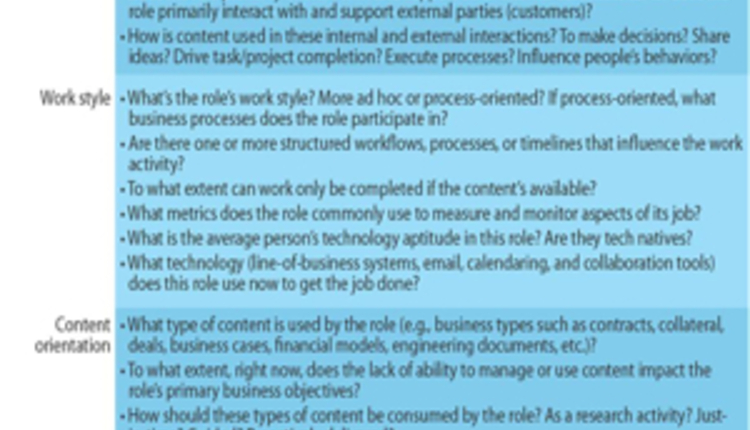How mobility, cloud computing, analytics and outsourcing are rocking ECM as we know it
Successful management of content throughout its life cycle has never been more challenging. Customers and employees, operating in a social, mobile world, expect easy mechanisms to create and consume content and automated approaches to the duty of protecting it. In the future, some things will remain the same, such as the fundamental drive to reliably manage and find content, but growth in content types, like activity streams from enterprise social platforms and the need to access content "in the moment" from the mobile world, will fundamentally alter the enterprise content management (ECM) landscape.
Empowered Mobile Users Carry a Mandate for Usability That Traditional ECM Can't Meet
Empowered mobile users have shaken the foundation of the traditional ECM ecosystem. The highly collaborative and mobile workforce has taken to cloud-based document solutions, such as Dropbox, like ducks to water. Why wouldn't they? Such tools are intuitive, available anywhere and inexpensive. However, these solutions lack metadata management, records management and process integration, which are critical to protect and secure content. Forrester predicts that the market will handle this disruption and reach a compromise of the productivity gains from "lighter" document solutions and control from the "private" network approach in three steps.
- Startup mobile and cloud-based file management solutions will provide immediate value. Emerging solutions like Egnyte, Dropbox and SugarSync work between multiple computers, mobile devices and cloud applications, both on and offline. The key to their success is that they oversee documents without having to put them under specific control, i.e., in a managed repository, and users don't have to think about anything in advance.
- Traditional ECM vendors acquire smart startups. In 2012, seasoned acquisition spotters EMC and OpenText pounced on startups Syncplicity and Tempo, providers of software to syncs files between computers and mobile devices and promote team-based collaboration. The real driver for acquisition, and the one that will help reshape the industry, is the viral adoption of lighter content solutions. Traditional ECM vendors will add a layer of control, security and compliance to these solutions.
- Future approaches will concentrate on integration and orchestration. Today, we describe ECM as an "either/or dichotomy" between a popular cloud-based file sharing system and unwieldy on-premise traditional ECM. The future will be a "both/and" scenario, with easy end user access points supported by built-in compliance and enforcement of enterprise-wide policies.
The 3 E's of Analytics Will Drive the Next Generation of ECM
Semantic search, metadata extraction from capture, auto classification, dynamic learning from forms processing and analytics are examples of intelligent technologies that will continue to reshape the industry. Major ECM players must acquire and absorb these technologies in order to add value to their solutions, as they hold promise to solve historic adoption problems and to steer the way to transparent management of content. Once content is better structured, it is easier to report and visualize trends.
Semantic software will release three sticky points of ECM: one, how to add context and intelligence to assets throughout their life cycle (enrichment), two, how to carry out retention and governance (enforcement) and three, how to optimize information intensive processes (efficiency).
- Enrichment: Analytics allows content to be annotated transparently. ECM will evolve to take pressure off administrators and users to add attributes and policy to content. Text mining will be used to identify and extract entities inherent in the content and then transparently add it to the metadata for that asset. More sophisticated applications of this capacity involve natural language processing to identify topics and not just attributes that follow a pattern, like a Social Security Number.
- Efficiency: Analytics supports straight-through processing of high-volume information. Leading capture providers incorporate analytics in their solution. For highly structured and predictable documents, like a survey, zonal OCR and mark sense will usually work to get accurate extraction results. For semi-structured documents, like a purchase order, clever analytics will help to create a library of templates that have various rules and techniques to improve extraction accuracy. The upside? Tighter integration with BPM solutions and less manual, repetitive and costly work.
- Enforcement: Analytics help retain each type of business record. One of the historical challenges of legacy records management applications has been the interface. Analytics can comb through a content collection to identify different record types and define classification rules for each type. It can then support automated or approval-based disposition of the content.
" Providers will need to embrace lighter cloud solutions but also devise a way to add a layer of security"
The Perennial ECM Requirement: Manage Risk and Ensure Compliance
As content grows and spreads across locations, it's imperative to protect critical intellectual property. An efficient, effective content management initiative doesn't just focus on the utility or business purpose of the information; it also focuses on the duty, or legal obligation, around specific information. Enterprises must protect valuable assets, meet a complex mix of regulations and be prepared to respond cost-effectively to litigation and investigations. However, enterprises won't realize the goal of efficient content management via a big monolithic technology investment. Enterprise architects should no longer assume that it's possible to run content management with a unified content repository. Instead, success requires a strong focus on developing solid policies, cross-functional alignment and pragmatic governance. Some key foundational capabilities to a transparent future and achieving true "corporate solutions" include:
- Intelligent migration to rationalize ECM systems. Top of mind for Forrester clients is how to develop an approach to reduce the number of content systems to apply governance and appropriate controls. The activity of migrating content will evolve from a "dumb forklift" to a constant opportunity for intelligent content processing — a chance to de-duplicate, annotate, cleanse and delete content.
- Records management to enable compliance and offer defensible disposition. The need for effective records management and defensible disposition practices will only increase with more information under consideration and accelerating e-discovery demands. Supporting strict guidelines and providing a consistent approach for retention, disposition and other policy controls will become increasingly important for enterprise architecture leaders.
- Rights management to protect key business documents. Enterprise rights management (ERM) applications enable organizations to provide persistent protection for valuable business documents. While the ability of ERM applications to control the usage, circulation and compartmentalization of content is compelling, these tools haven't had a lot of traction due to high cost, application rigidity and integration shortcomings. Over the next three years, tighter ties with content management will ease frustrations in applying protection polices with a mix of cloud-based and on-premise applications.
What Does it Mean? Prepare For a Redefined Content Management Universe
Enterprise content management has been alive and kicking as a technology market for several decades. Today's document management assumes a private corporate network with a controlled repository. Tomorrow's document management, however, will rely on the worldwide Internet with access to documents stored in various cloud locations. Providers will need to embrace lighter cloud solutions and drive them toward industry solutions but also devise a way to add a layer of security that makes enterprise customers comfortable. At the same time, enterprises will need to push previously trapped corporate content securely outside the firewall to customers and partners. Looking ahead, organizations must set the groundwork for innovative content management strategies based on a redefined content management universe.
CRAIG LE CLAIR is a vice president and principal analyst at Forrester Research, serving enterprise architecture professionals. For more, visit www.forrester.com/Craig-Le-Clair.
















